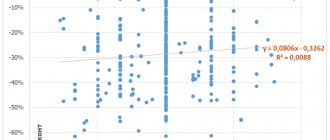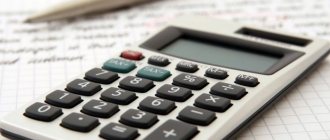Market price
the most probable price at which the valued object can be alienated on the open market in a competitive environment, when the parties to the transaction act reasonably, having all the necessary information, and the transaction price is not affected by any extraordinary circumstances.
Market value is determined in cases where:
- a transaction is envisaged for the alienation of the valuation object, including when determining the redemption price, when withdrawing the valuation object in the absence of state regulated prices, or for state needs;
- when determining the value of the company's outstanding shares acquired by the company by decision of the general meeting of shareholders or by decision of the board of directors (supervisory board) of the company;
- the object of assessment is the object of collateral, including in the case of a mortgage;
- when making non-monetary contributions to the authorized (share) capital, when determining the value of property received free of charge;
- when determining the value of securities that either are not traded at auctions of trade organizers on the securities market, or have been traded at auctions of trade organizers on the securities market for less than six months;
- when deciding on the initial sale price of property in bankruptcy proceedings.
Ministry of Economic Development of the Russian Federation
Order
September 25, 2014 No. 611
On approval of the Federal Valuation Standard “Real Estate Valuation (FSO No. 7)” In accordance with Article 20 of the Federal Law of July 29, 1998 No. 135-FZ “On Valuation Activities in the Russian Federation” (Collected Legislation of the Russian Federation, 1998, No. 31, Art. 3813; 2006, No. 31, Art. 3456; 2010, No. 30, Art. 3998; 2011, No. 1, Art. 43; No. 29, Art. 4291; 2014, No. 30, Art. 4226) I order:
Approve the attached Federal Valuation Standard “Real Estate Valuation (FSO No. 7)”. Minister A.V. Ulyukaev
APPROVED by order of the Ministry of Economic Development of Russia dated September 25, 2014 No. 611
Federal Valuation Standard “Real Estate Valuation (FSO No. 7)”
I. General provisions
1. This Federal Valuation Standard has been developed taking into account international valuation standards and federal valuation standards “General concepts of valuation, approaches to valuation and requirements for valuation (FSO No. 1)”, “Purpose of valuation and types of value (FSO No. 2)”, “ Requirements for an assessment report (FSO No. 3)” (hereinafter referred to as FSO No. 1, FSO No. 2, FSO No. 3) and defines the requirements for conducting a real estate assessment.
2. This Federal Valuation Standard develops, supplements and specifies the requirements and procedures established by FSO No. 1, FSO No. 2, FSO No. 3, and is mandatory for use when appraising real estate.
3. The provisions of this Federal Valuation Standard do not apply to the valuation of aircraft and sea vessels, inland navigation vessels, space objects, subsoil plots, enterprises as property complexes subject to state registration, as well as to the determination of the cadastral value of real estate using mass valuation methods.
II. Objects of assessment
4. For the purposes of this Federal Standard, the objects of assessment may be real estate objects - developed land plots, undeveloped land plots, capital construction projects, as well as parts of land plots and capital construction projects, residential and non-residential premises, together or separately, taking into account related their property rights, if this does not contradict current legislation. For the purposes of this Federal Standard, the objects of valuation may be shares in the right to real estate.
III. General requirements for conducting an assessment
5. When collecting information about the property being appraised, the appraiser or his representative conducts an inspection of the property being appraised during a period possibly close to the appraisal date, unless otherwise specified in the appraisal assignment. In case of failure to conduct an inspection, the appraiser indicates in the evaluation report the reasons why the object of assessment was not inspected, as well as assumptions and limitations associated with the failure to conduct an inspection.
6. A joint assessment of a land plot and capital construction projects located on it in the absence of title and title documents for the land plot is carried out taking into account the rights and obligations of the owner of capital construction projects in relation to the land plot established by current legislation, as well as the typical behavior of owners in relation to similar land plot (purchase or lease).
7. In the absence of documented property rights of third parties in relation to the property being assessed, restrictions (encumbrances), as well as environmental pollution, the assessment of the object is carried out based on the assumption of the absence of such rights, restrictions (encumbrances) and pollution, taking into account the circumstances identified during the inspection , unless otherwise specified in the assessment assignment.
IV. Assessment task
8. The assignment for the assessment of a property must contain the following additional information to that specified in paragraph 17 of FSO No. 1:
• composition of the object of assessment, indicating information sufficient to identify each of its parts (if available); • characteristics of the appraised object and its appraised parts or links to documents available to the appraiser containing such characteristics; • rights taken into account when assessing the subject of assessment, restrictions (encumbrances) of these rights, including in relation to each part of the subject of assessment.
9. The assessment assignment may indicate other calculated values, including:
• market rent (the estimated amount of money for which a property could be rented at the valuation date under typical market conditions); • costs of creation (reproduction or replacement) of capital construction projects; • losses (actual damage, lost profits) upon alienation of a property, as well as in other cases; • costs of eliminating environmental pollution and (or) reclamation of a land plot.
V. Market analysis
10. To determine the value of real estate, the appraiser examines the market in those segments that include the actual use of the property being valued and other types of use necessary to determine its value.
11. Analysis of the real estate market is carried out in the following sequence:
a) analysis of the impact of the general political and socio-economic situation in the country and region where the property being assessed is located on the market of the property being assessed, including trends that have emerged in the market in the period preceding the date of assessment;
b) determination of the market segment to which the valued object belongs. If the real estate market is underdeveloped and there is insufficient data to provide an idea of the prices of transactions and (or) offers with comparable real estate objects, it is possible to expand the study area to territories that are similar in economic characteristics to the location of the property being evaluated; c) analysis of actual data on the prices of transactions and (or) offers with real estate objects from market segments to which the valued object can be classified under actual, as well as alternative options for its use, indicating the range of price values;
d) analysis of the main factors influencing the demand, supply and prices of comparable real estate, for example, rates of return, payback periods for investments in the real estate market, with intervals for the values of these factors;
e) main conclusions regarding the real estate market in the segments necessary to evaluate the property, for example, market dynamics, demand, supply, sales volume, market capacity, motivation of buyers and sellers, liquidity, price fluctuations in the market of the property being assessed and other conclusions. The scope of research is determined by the appraiser based on the principle of sufficiency.
VI. Best use analysis
12. Highest use analysis underlies estimates of the market value of real estate.
13. The most effective use is that use of real estate that maximizes its productivity (corresponds to its highest value) and which is physically possible, legally permitted (at the date of determination of the value of the property being assessed) and financially justified.
14. The most effective use of a real estate property may correspond to its actual use or involve other use, for example, repair (or reconstruction) of capital construction facilities existing on the land plot.
15. Analysis of the most effective use allows us to identify the most profitable use of the property, which market participants (buyers and sellers) focus on when setting the transaction price. When determining the market value, the appraiser is guided by the results of this analysis to select approaches and methods for valuing the property being appraised and selecting comparable real estate when applying each approach.
16. Analysis of the most effective use of the object being assessed is carried out, as a rule, based on space-planning and design solutions. For assessment objects, which include a land plot and capital construction objects, the most effective use is determined taking into account the existing capital construction objects. In this case, such an analysis is carried out by carrying out the necessary calculations or without them, if justifications are presented that do not require calculations.
17. An analysis of the most effective use of parts of a real estate property, for example built-in residential and non-residential premises, is carried out taking into account the actual use of other parts of this property.
18. An analysis of the most effective use of a part of a real estate property being reconstructed or subject to reconstruction is carried out taking into account the most effective use of the entire property being reconstructed.
19. The most effective use of a property valued individually may differ from its most effective use as part of the valued complex of real estate objects.
20. The market value of a land plot built up with capital construction projects, or capital construction projects for entering this value into the state real estate cadastre, is assessed based on the type of actual use of the property being valued. In this case, the developed land plot is assessed as undeveloped, intended for use in accordance with the type of its actual use.
21. An analysis of the most effective use of a real estate property for rent is carried out taking into account the conditions of use of this property established by the lease agreement or the draft of such an agreement.
VII. Approaches to assessment
22. When applying a comparative approach to real estate valuation, the appraiser takes into account the following provisions:
a) a comparative approach is used to evaluate real estate, when it is possible to select a sufficient number of analogous objects with known transaction and (or) offer prices for evaluation;
b) real estate objects that belong to the same market segment as the object being valued and are comparable to it in terms of pricing factors are used as analogue objects. At the same time, for all real estate objects, including the one being assessed, pricing for each of these factors must be uniform;
c) when conducting an assessment, the volume of market data available to the appraiser about similar objects and the rules for their selection for calculations must be described. The use in calculations of only part of the analogous objects available to the appraiser must be justified in the assessment report;
d) to perform calculations, specific indicators of value (comparison units) that are typical for a similar object, prevailing on the market of the object being valued, are used, in particular the price or rent per unit of area or unit of volume;
e) depending on the initial information available on the market, in the process of real estate valuation, qualitative valuation methods (relative comparative analysis, expert assessment method and other methods), quantitative valuation methods (regression analysis method, quantitative adjustment method and other methods), as well as their combinations.
When applying qualitative methods, real estate valuation is carried out by studying the relationships identified based on the analysis of transaction prices and (or) offers with similar objects or relevant information received from experts, and using these relationships to conduct an assessment in accordance with the technology of the method chosen for evaluation.
When applying the adjustment method, each analogue object is compared with the valued object according to price-forming factors (comparison elements), differences between objects are identified by these factors, and the price of the analogue object or its specific indicator is adjusted according to the identified differences in order to further determine the value of the valued object. In this case, the adjustment for each element of comparison is based on the principle of the contribution of this element to the cost of the object.
When applying regression analysis methods, the appraiser, using data from the market segment of the object being valued, constructs a pricing model that corresponds to the market for this object, from which he determines the estimated value of the sought value;
f) to compare the valuation object with other real estate objects with which transactions have been made or which are presented on the market for their completion, the following elements of comparison are usually used:
• transferred property rights, restrictions (encumbrances) on these rights; • terms of financing of a completed or proposed transaction (type of payment, credit conditions, other conditions); • terms of sale (conditions atypical for the market, transaction between affiliates, other conditions); • market conditions (price changes for the period between the transaction and valuation dates, discounts to offer prices, other conditions); • type of use and (or) zoning; • location of the object; • physical characteristics of the object, including the properties of the land plot, the condition of capital construction objects, the ratio of the area of the land plot and its built-up area, other characteristics; • economic characteristics (level of operating expenses, lease terms, composition of tenants, other characteristics); • availability of movable property not related to real estate; • other characteristics (elements) affecting the cost;
g) in addition to cost, the comparative approach can be used to determine other estimates, such as rental rates, depreciation and obsolescence, capitalization rates and discount rates.
23. When applying the income approach, the appraiser takes into account the following provisions:
a) the income approach is used to value real estate that generates or is capable of generating income streams;
b) within the framework of the income approach, the value of real estate can be determined by the direct capitalization method, the discounted cash flow method or the capitalization method using calculation models;
c) the direct capitalization method is used to evaluate real estate assets that do not require significant capital investments in their repair or reconstruction, the actual use of which corresponds to their most effective use. Determining the value of real estate objects using this method is carried out by dividing the annual income from the object corresponding to the market by the total capitalization rate, which is determined based on the analysis of market data on the ratio of income and prices of real estate objects similar to the object being valued;
d) the discounted cash flow method is used to evaluate real estate that generates or is capable of generating income streams with arbitrary dynamics of their changes over time by discounting them at a rate corresponding to the return on investment in similar real estate;
e) the capitalization method based on calculation models is used to evaluate real estate that generates regular income streams with the expected dynamics of their change. Capitalization of such income is carried out at a general capitalization rate, constructed on the basis of the discount rate taken into account in the calculation of the capital return model, methods and conditions of financing, as well as expected changes in income and property value in the future;
f) the structure (taking into account taxes, return of capital, rate of change in income and asset value) of the discount rates and (or) capitalization used must correspond to the structure of the discounted (capitalized) income;
g) for real estate that can be rented out, rental payments should be considered as a source of income;
h) the valuation of real estate intended for running a certain type of business (for example, hotels, restaurants, gas stations) can be carried out on the basis of information about the operating activities of this business by separating from its value components that are not related to the real estate being valued.
24. When applying the cost approach, the appraiser takes into account the following provisions:
a) the cost approach is recommended to be used for the valuation of real estate - land plots built up with capital construction projects, or capital construction projects, but not their parts, for example, residential and non-residential premises;
b) it is advisable to use the cost approach to evaluate real estate if it corresponds to the most efficient use of the land plot as undeveloped and it is possible to correctly assess physical wear and tear, as well as functional and external (economic) obsolescence of capital construction projects;
c) the cost approach is recommended to be used when market activity is low, when there is insufficient data necessary to apply the comparative and income approaches to valuation, as well as to evaluate real estate for special purposes and uses (for example, linear objects, hydraulic structures, water towers, pumping stations, boiler houses , utility networks and other real estate for which there are no market data on transactions and offers);
d) in general, the value of a property, determined using the cost approach, is calculated in the following sequence: • determining the value of rights to a land plot as undeveloped; • calculation of costs for the creation (reproduction or replacement) of capital construction projects; • determination of the entrepreneur's profit; • determination of wear and tear and obsolescence; • determining the cost of capital construction projects by summing up the costs of creating these facilities and the entrepreneur’s profit and subtracting their physical wear and tear and obsolescence; • determining the value of a real estate property as the sum of the value of rights to a land plot and the cost of capital construction projects;
e) for the purpose of determining the market value of a property using the cost approach, the land plot is assessed as undeveloped, assuming its most effective use;
f) calculation of costs for the creation of capital construction projects is carried out on the basis of: • data on construction contracts (agreements) for the construction of similar objects; • data on the costs of construction of similar facilities from specialized directories; • cost estimates; • information on market prices for building materials; • other data;
g) the costs of creating capital construction projects are defined as the sum of the costs included in the construction and installation work directly related to the creation of these objects, and the costs associated with their creation, but not included in the construction and installation work;
h) for the purpose of assessing the market value of real estate, the amount of profit of an entrepreneur is determined on the basis of market information using extraction methods, expert assessments or analytical models, taking into account direct, indirect and opportunity costs associated with the creation of capital construction projects and the acquisition of rights to a land plot;
i) the amount of wear and tear and obsolescence is defined as the loss of real estate value as a result of physical wear and tear, functional and external (economic) obsolescence. At the same time, wear and tear and obsolescence relate to capital construction projects related to the real estate being assessed.
25. The appraiser has the right to use a different calculation methodology and independently determine the method (methods) of real estate valuation within each of the selected approaches, based on the principles of materiality, validity, unambiguity, verifiability and sufficiency. In this case, the assessment report must provide a description of the method(s) chosen by the appraiser, allowing the user of the assessment report to understand the logic of the process of determining the value and the compliance of the method(s) chosen by the appraiser with the property, the principles of assessment, the type of value being determined and the intended use of the assessment results.
VIII. Coordination of assessment results
26. Coordination of real estate assessment results obtained using various methods and approaches to assessment, and reflection of its results in the assessment report, is carried out in accordance with the requirements of FSO No. 1 and FSO No. 3.
27. If several valuation methods are used within any approach to real estate valuation, preliminary approval of their results is carried out in order to obtain an intermediate result of real estate valuation using this approach.
28. In the process of coordinating the intermediate results of real estate valuation obtained using different approaches, it is necessary to analyze the advantages and disadvantages of these approaches, explain the discrepancy between the intermediate results and, based on the analysis, determine the final result of the real estate valuation.
29. If there is insufficient market data necessary to implement any of the approaches to real estate valuation in accordance with the requirements of this Federal Valuation Standard and FSO No. 1, FSO No. 2, FSO No. 3, within the framework of the chosen approach based on the available data, it is recommended to indicate indicative values (value) of the value being assessed, which are not taken into account in the final approval, but can be used as verification for the final result of the real estate assessment.
30. After the approval procedure, the appraiser, in addition to indicating in the assessment report the final result of the assessment of the value of real estate, gives his judgment on the possible boundaries of the interval in which, in his opinion, this value may be located, unless otherwise indicated in the assessment task.
Investment cost
the value of a property to a particular investor or class of investors for specified investment purposes. This subjective concept relates a specific property to a specific investor, group of investors or organization that has specific investment goals and/or criteria. The investment value of the appraisal object may be higher or lower than the market value of this appraisal object.
Investment value is determined in the following cases:
- if a transaction is expected to be completed with the object of evaluation in the presence of a single counterparty;
- if the object of assessment is considered as a contribution to the investment project;
- when justifying or analyzing investment projects;
- when implementing measures to reorganize the enterprise.
What is the price and value of real estate
When considering the issue of measuring the financial indicators of real estate, such as its cost and profitability, first of all, you should pay attention to the significance of the wording. It is important to distinguish between terms such as “price” and “cost”.
Price of an agreement between the parties about how much the recipient of a piece of real estate (or a real estate investment instrument) will pay its seller . Of course, the price, in a practical sense, is an expression of the value of the subject of the transaction acceptable to each of the parties. However, in a strict sense, it can either coincide or differ from the market value of the subject of the transaction, comparison with which is the basis for determining the profitability of the purchase (if the price is lower than the cost, then the transaction is beneficial for the buyer, if higher, vice versa).
Cost ( Value ) is only a calculated indicator. It shows the equilibrium price expected on average in the market for the subject of the transaction. For investment transactions, it is the price that reflects the potential for profitability that a particular investment will bring. The value of investing in commercial real estate is usually assessed at two levels:
- Property Value is the amount at which the property itself is valued. Valuation is made only in relation to the rights to the object and the associated cash flows.
- Asset Value assumes that the subject of valuation includes both the real estate itself and other property associated with it, for example, retained earnings in the form of cash, tenant deposits, accounts receivable. In this case, the following are distinguished:
- gross asset value (Gross Asset Value, GAV), which includes the valuation of only property (actually the various types of assets listed above);
Net Asset Value (NAV) is the gross value of assets (GAV) minus the liabilities covered by the value of these assets, that is, liabilities to various types of creditors: suppliers, banks (in case of raising debt). NAV is the final indicator of the value of investors' own capital. For example, for investors in a real estate fund, the NAV (or NAV) of that fund measures the value of their investment at each point in time as the aggregate value of all the shares of the fund in which they are equity investors.
Liquidation value
the most probable price at which the subject property can be alienated in a period insufficient to attract a sufficient number of potential buyers, or in conditions where the seller is forced to make a transaction to alienate the property.
The liquidation value is determined when the property of a bankrupt enterprise is sold at an open auction, the property is seized as a result of legal proceedings, or at customs. The liquidation value can be determined in addition to the market value when lending against property.
Cost estimation methods
For a real estate investor, the question of the value of the property (and its relationship with the actual price) is decisive in the matter of calculating the potential return on the amount of risk taken. The price of the property upon purchase, as well as in the future (by the date of the proposed sale, which many do not think about) will determine how much the investor will earn. How to determine how much a property is worth? Is the value of the object equal to the proposed transaction price for its purchase or sale? These are simple questions with complex answers because real estate valuation never comes down to just one metric.
Considering that any investment is the acquisition of future cash flow, the key methods of real estate valuation in the context of investment are income valuation methods, followed by the comparative method, as well as the cost method, to verify data.
30 Jul. 2021
Replacement cost
(cost of reproduction and replacement) - the amount of costs in market prices existing on the date of the assessment, to create an object identical to the object of assessment, using identical materials and technologies, or to create an object similar to the object of assessment, using those existing on the date of assessment materials and technologies.
Replacement cost is determined:
- when calculating the tax base for income tax and property tax;
- for tax accounting purposes when making a fixed asset as a contribution to the authorized capital;
- when revaluing fixed assets for accounting purposes;
- within the framework of the cost approach when assessing property.
Replacement cost can be determined when insuring property.
Special price
value additional to market value that may arise from the physical, functional, or economic connection of a piece of property with some other piece of property. A special value is an additional value that may exist more for a buyer with a special interest than for the market as a whole. In particular, a special cost can be calculated in order to determine the synergistic effect during the reorganization of an enterprise.









